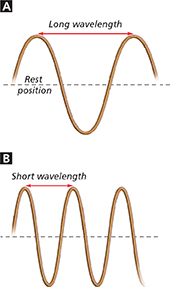Quick Lab
Comparing Frequency and Wave Speed
Materials
3-m rope, tape measure, stopwatch
Procedure 
Tie one end of the rope to a chair. Shake the other end to send waves down the rope.
With a partner, measure the time it takes your hand to move back and forth ten times. Then, measure and record the distance from your hand to the chair and the time it takes a wave crest to travel this distance.
Repeat Step 2, but this time shake the rope more rapidly. Record your data.
Analyze and Conclude
Calculating What was the frequency of the waves in Steps 2 and 3? (Hint: Divide 10 waves by the time it took to make them.)
Calculating What was the wave speed in Steps 2 and 3? (Hint: Divide distance by time.)
Drawing Conclusions How was wave speed affected by increasing the frequency?
Wavelength
Wavelength is the distance between a point on one wave and the same point on the next cycle of the wave. For a transverse wave, wavelength is measured between adjacent crests or between adjacent troughs. For a longitudinal wave, wavelength is the distance between adjacent compressions or rarefactions. Notice in Figure 6 that when wavelength is shorter, crests are closer together. They must occur more frequently.
 Increasing the frequency of a wave decreases its wavelength.
Increasing the frequency of a wave decreases its wavelength.
 What is wavelength?
What is wavelength?
Figure 6 Wavelength can be measured from any point on a wave to the same point on the next cycle of the wave. A The wavelength of a transverse wave equals the distance from crest to crest or from trough to trough. B. The wavelength of this wave is half the wavelength of the wave in A. Inferring Which wave has a greater frequency?

Wave Speed
Recall that the speed of an object equals distance divided by time. To calculate a swimmer's speed, for example, you can measure the length of one lap in a pool and the time it takes to swim one lap. This is like measuring the wavelength (one lap) and period (time to swim one lap) of the swimmer's motion. In much the same way, you can calculate the speed of a wave by dividing its wavelength by its period. You can also calculate wave speed by multiplying wavelength by frequency.
Speed of Waves

When the wavelength is in meters and the frequency is in hertz, the units for speed are meters per second. If you know any two of the values in this formula, you can solve for the third value.




